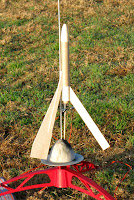
While the instructions don't say to do so, I rounded the leading and trailing edges of the fins before gluing them onto the lower body tube.
The two lower stabilizer fins are spaced at 18mm apart.













I cut mine a little oversize so I could sand it down to the outside edges once all three parts had dried. I made sure that the inside spacer's 90 degree edge sat in the right position as the original, slightly smaller spacer.
I clamped the three pieces together with clothes pins for drying.
With the spacer between the two spars, there is a long open "slot" for the upper main fin.

First up, you are to punch a hole in the longer BT-20 for an ejection charge vent. This went much better than I thought it would.
The smaller side of the hole punch is inserted as far as it will go into the tube.
The punched hole was easy and the cut edges were round and sharp!


Click on the pictures for an enlargement.






 In the end, I decided to leave off the forward "guns'. They just looked too big and clumsy. I'm still deciding which decals (if any) I'll be using.
In the end, I decided to leave off the forward "guns'. They just looked too big and clumsy. I'm still deciding which decals (if any) I'll be using.
I didn't do a blog entry about attaching the streamer, it's a simple assembly. The Kevlar line wasn't attached to the engine block, it was glued to the root edge of one of the white vane fins.












The carded MISSLE TOE flew first followed by the Bob Harrington RED MAX downscale both with MicroMaxx engines. No wadding and nose-blow recovery on both.

The FlisKits INTERLOPER first flight was very high with MicroMaxx Power. Full streamer deploy and a little drift.
So far, my experiences with all the FlisKit micro models has been positive, they are perfect small field fliers.

The UP! CUP launch was LOUD!
I'm convinced the cup amplifies the noise of the thrust. The old B6-2 did it's job and ejected on a streamer.
The picture shows the landing. It floated down, hit the ground and did a small bounce. The 180 degree flip left it like this!
Last up was the new CYCLONE.
During boost, you could hear a distinct whistle from the ejection port hole.
It was a good thing I moved the launcher farther up the field.
At ejection, the upper half did it's fast spin and almost landed in the road. With a 1/2A3-2t engine it drifted about 200 feet away.
Both the UP! CUP and CYCLONE are being developed as Odd'l Rockets kits.
